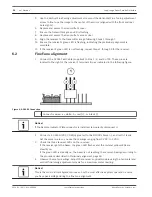
Figure 2.3: Beam Blockage
1 Transmitter
3 Blocking object
2 Beam
4 Receiver
The receiver automatically compensates for the gradual signal loss because of dust and dirt
buildup on the cover. After a signal loss of 50%, the receiver indicates a trouble. When the
built‑up dust and dirt are cleaned or the blockage is removed, the detector automatically
returns to its normal operation level.
The receiver indicates a trouble if the beam strength increases by more than 20% for longer
than 20 sec. A trouble can be caused by an initial misalignment or the removal of a partial
beam blockage during alignment. Perform a fine‑tune alignment.
For alignment details, see Setup, page 17.
Installation considerations
Correct smoke detector location and spacing is critical in a properly installed and operating
fire alarm system. For best results, place and space the detectors according to the National
Fire Protection Association (NFPA) Standard 72, The National Fire Code.
In all installations, good engineering judgment must prevail.
–
Do not use mirrors. Install detectors with a clear line-of-sight between the transmitter
and receiver.
–
Clear the beam path of moving objects.
–
Avoid areas with normal smoke concentrations, such as kitchens and garages.
–
Do not install detectors where the normal ambient temperatures are below -22°F (-30°C)
or above +130°F (+54°C).
–
Set sensitivity based on the distance between the transmitter and receiver. For
information on selecting and setting sensitivity, see Design for the expected fire load, page
8 and Sensitivity setting, page 11.
Avoid air movement sources
–
Place the transmitters/receivers where the beam path does not pass near heating and
cooling outlets. Do not mount where hot or cold air blows directly into the beam path.
Heating, ventilating, and air conditioning (HVAC) systems can blow smoke away from the
beam path. Smoke must accumulate in the beam path to be detected.
–
Do not mount heaters close to the beam path. Heat can distort the beam.
–
Test for beam distortion by monitoring the signal voltage. After setup, the detector’s
signal voltage must read between 3.8 VDC and 4.2 VDC. Monitor the voltage and turn on
all heating and cooling devices in the area. The signal voltage must not fluctuate more
than 0.20 VDC. If it does, relocate the detector to avoid these disturbances.
3
3.1
6
en | Notices
Long-range Beam Smoke Detectors
2014.01 | 06 | F.01U.068.899
Installation Instructions
Bosch Security Systems, Inc.







































